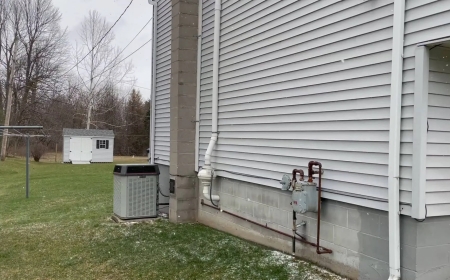How To Hike Trinity Skyline Trail Dallas Sunset
How to Hike Trinity Skyline Trail Dallas Sunset The Trinity Skyline Trail in Dallas, Texas, is more than just a hiking path—it’s a gateway to one of the most breathtaking urban sunset experiences in the Southwest. Nestled along the Trinity River, this trail offers hikers panoramic views of the Dallas skyline, rolling prairie landscapes, and the golden hues of dusk painting the city’s iconic skyscr
How to Hike Trinity Skyline Trail Dallas Sunset
The Trinity Skyline Trail in Dallas, Texas, is more than just a hiking path—it’s a gateway to one of the most breathtaking urban sunset experiences in the Southwest. Nestled along the Trinity River, this trail offers hikers panoramic views of the Dallas skyline, rolling prairie landscapes, and the golden hues of dusk painting the city’s iconic skyscrapers in warm amber and rose tones. Unlike traditional nature trails that require long drives to remote areas, the Trinity Skyline Trail delivers a wilderness-like escape within the heart of a major metropolitan area, making it uniquely accessible for urban dwellers seeking solitude, exercise, and awe-inspiring natural beauty.
As Dallas continues to grow, preserving and promoting green spaces like this trail becomes increasingly vital. The Trinity Skyline Trail is part of a larger vision to reconnect the city with its riverfront, transforming neglected corridors into vibrant public realms. For hikers, photographers, and nature enthusiasts, witnessing a sunset along this trail is not merely a recreational activity—it’s a sensory experience that blends urban energy with natural tranquility. Understanding how to properly prepare for, navigate, and enjoy this trail at sunset ensures not only safety but also a deeply rewarding encounter with one of Dallas’s most underrated natural assets.
This guide provides a comprehensive, step-by-step roadmap for hiking the Trinity Skyline Trail at sunset. From trail logistics and timing to gear recommendations and photography tips, you’ll learn everything needed to make your experience seamless, safe, and unforgettable. Whether you’re a first-time visitor or a seasoned local, this tutorial will elevate your hike from ordinary to extraordinary.
Step-by-Step Guide
1. Research and Plan Your Route
The Trinity Skyline Trail is not a single linear path but a network of interconnected segments. The most popular sunset route begins at the Trinity River Audubon Center in North Dallas and follows the trail southward toward the Margaret Hunt Hill Bridge, offering unobstructed views of downtown’s skyline as the sun dips below the horizon. This segment spans approximately 4.5 miles round-trip, with a moderate elevation gain and well-maintained, paved pathways suitable for most fitness levels.
Before heading out, consult the official Trinity River Audubon Center Trail Map or use a trusted hiking app like AllTrails or Gaia GPS. These platforms provide real-time updates on trail conditions, recent maintenance, and user-reported closures. Pay attention to trail markers—blue diamonds indicate the main Skyline Trail route, while green markers lead to side paths and overlooks.
For sunset viewing, aim to reach the overlook near the Margaret Hunt Hill Bridge by 7:30 PM during spring and summer months, or 6:30 PM in fall and winter. Sunset times vary seasonally; use an app like Sun Surveyor or The Photographer’s Ephemeris to pinpoint exact times and sun angles for optimal lighting.
2. Choose the Right Time of Year
While the Trinity Skyline Trail is accessible year-round, the best conditions for a sunset hike occur between late March and early November. During these months, daylight lasts longer, temperatures are milder, and the sky remains clear more frequently. Summer evenings can be hot and humid, so plan your hike for early dusk when the air still holds some coolness from the day.
Winter hikes offer crisp, clear skies and fewer crowds, but sunset occurs earlier—sometimes as early as 5:45 PM in December. If you’re hiking in winter, bring layered clothing and consider starting your hike earlier to avoid complete darkness by the time you return.
Avoid hiking during heavy rain or thunderstorms. The trail can become slippery, and lightning poses a serious risk in open areas near the river. Check the National Weather Service forecast for Dallas before leaving home.
3. Pack Essential Gear
Even though the trail is urban and well-traveled, being prepared can mean the difference between a pleasant outing and an uncomfortable or unsafe one. Here’s what to bring:
- Comfortable hiking shoes with good grip—paved paths are generally smooth, but gravel sections and occasional mud puddles require sturdy footwear.
- Hydration—carry at least 20 oz of water per person. There are no water fountains along the trail after the Audubon Center.
- Light snacks—energy bars, nuts, or fruit to maintain stamina.
- Headlamp or flashlight—even if you plan to finish before full darkness, trails are not lit, and you may linger for sunset photos.
- Lightweight jacket or windbreaker—temperatures can drop significantly after sunset, especially near the river.
- Phone with offline maps—cell service can be spotty in parts of the trail.
- Binoculars—optional but highly recommended for spotting birds, distant landmarks, and city lights as they turn on.
- Camera with tripod—if you plan to photograph the sunset, a small, portable tripod will stabilize your shots and allow for longer exposures.
Leave behind unnecessary items. The trail is not equipped with trash bins beyond the Audubon Center, so carry out everything you bring in. Practice Leave No Trace principles to preserve the natural environment.
4. Start at the Trinity River Audubon Center
Your journey begins at the Trinity River Audubon Center, located at 5300 S. Riverfront Blvd, Dallas, TX 75217. This LEED-certified facility serves as both an educational hub and trailhead. Parking is free and ample, with designated spots for cars, bikes, and ADA-accessible vehicles.
Before you start hiking, take a moment to visit the center’s indoor exhibits. The interpretive displays on local bird species, riparian ecosystems, and conservation efforts enhance your appreciation of the landscape you’re about to traverse. Restrooms are available here, and you can refill water bottles at the filtered water station.
Exit the center via the main trailhead marked with a blue diamond. The first 0.8 miles follow a gentle, elevated boardwalk that winds through wetlands and native grasses. This section is shaded by live oaks and cottonwoods, offering a cool, serene start to your hike. Watch for great blue herons, red-winged blackbirds, and the occasional white-tailed deer along the water’s edge.
5. Navigate the Trail to the Sunset Overlook
After the boardwalk, the trail transitions into a wide, paved path that parallels the Trinity River. This stretch is flat and easy to walk, making it ideal for families and casual hikers. Stay on the main path—side trails may lead to private property or closed areas.
At approximately 1.8 miles, you’ll pass the Trinity River Bridge Viewpoint, a popular spot for photos of the bridge and river. Continue south for another 1.2 miles until you reach the Margaret Hunt Hill Bridge Overlook. This is your sunset destination.
The overlook is an open, grassy area with a low stone wall and benches. It faces directly west, offering a clear, unobstructed view of downtown Dallas. As the sun begins to set, the glass towers of the Bank of America Plaza, Comerica Bank Tower, and the Reunion Tower glow in golden light, reflecting off the river below. The bridge’s cable design creates dramatic silhouettes against the sky.
Arrive at least 20–30 minutes before sunset to secure a good viewing spot. The overlook can fill up quickly on weekends and during peak seasons. Be respectful of others—keep noise to a minimum and avoid blocking paths or views.
6. Capture the Sunset Experience
If you’re photographing the sunset, set your camera to manual mode. Use a low ISO (100–400), aperture between f/8 and f/16 for depth of field, and shutter speed starting at 1/30s, adjusting as the light fades. Bracket your exposures to capture detail in both the sky and the city lights. A polarizing filter can reduce glare on the water and enhance cloud color.
For smartphone users, enable Pro or Manual mode if available. Tap to focus on the horizon, then lock exposure. Use the timer function to avoid camera shake. Shoot in RAW format for better post-processing flexibility.
Don’t forget to put your camera down occasionally. Take a moment to simply watch the sky shift from orange to violet, to hear the quiet hum of the city waking up at night, and to feel the cool evening breeze. This is the soul of the experience.
7. Return Safely After Dark
Once the sun has set and the city lights are fully illuminated, begin your return journey. The trail is not illuminated, so your headlamp is essential. Walk slowly and stay alert—while the trail is generally safe, there may be uneven pavement, roots, or wildlife crossing the path.
Consider hiking back with a partner or group. Solo hikers should inform someone of their expected return time. Avoid using headphones so you can hear your surroundings.
As you retrace your steps, notice how the landscape transforms after dark. The river reflects the city lights like liquid gold, and the Audubon Center’s building glows warmly against the darkening sky. The return trip feels different—quieter, more introspective, and deeply peaceful.
8. Complete Your Experience at the Audubon Center
When you return to the Trinity River Audubon Center, take a moment to reflect. Many hikers find the experience so enriching that they return the next day or bring friends. Consider signing the guestbook, donating to the center, or volunteering for a trail cleanup. Supporting the organization ensures this trail remains protected and accessible for future generations.
Before leaving, check your gear. Ensure you’ve collected all belongings, including any trash, water bottles, or camera accessories. Lock your car, and drive home with a sense of accomplishment and connection to the land.
Best Practices
Respect the Environment
The Trinity Skyline Trail runs through a sensitive riparian ecosystem. Avoid stepping off the trail, even to take a shortcut or get a better photo. Native plants like switchgrass, black-eyed Susans, and eastern red cedars are vital to the river’s health. Disturbing them can lead to erosion and loss of habitat for birds and insects.
Never feed wildlife. Squirrels, raccoons, and birds may approach you, especially near the Audubon Center, but human food can make them sick or dependent on handouts. Keep snacks sealed and dispose of wrappers properly.
Follow Trail Etiquette
The trail is shared by hikers, joggers, cyclists, and birdwatchers. Always yield to others: step aside to let faster users pass, announce your presence when approaching from behind (“On your left!”), and keep pets on a leash no longer than 6 feet. Dogs are permitted but must be under control at all times.
Keep noise levels low. This is a place for quiet reflection, not social gatherings. Avoid loud music, shouting, or amplified devices. Use headphones if you must listen to audio.
Stay Aware of Your Surroundings
While Dallas is generally safe, urban trails can attract opportunistic behavior after dark. Avoid wearing flashy jewelry or carrying visible electronics. Keep your phone in a secure pocket. If you feel uneasy, walk toward well-lit areas or exit the trail and head to a nearby business.
Be mindful of weather changes. Even on clear days, sudden thunderstorms can roll in from the west. If you hear thunder or see dark clouds gathering, seek shelter immediately. Do not remain on open overlooks during electrical storms.
Plan for Accessibility
The main trail from the Audubon Center to the Margaret Hunt Hill Bridge is fully ADA-compliant, with smooth pavement, gentle slopes, and accessible restrooms at the trailhead. However, some side trails and viewing platforms may have gravel or uneven surfaces. If you have mobility concerns, contact the Audubon Center in advance to confirm accessibility of your desired route.
Hydrate and Fuel Appropriately
Even short hikes can dehydrate you, especially in Texas heat. Drink water before you start, during your hike, and after you finish. Avoid sugary drinks—they cause energy crashes. Eat a light, balanced meal 1–2 hours before hiking. Avoid heavy, greasy foods that can cause sluggishness.
Leave No Trace
Adhere to the seven Leave No Trace principles:
- Plan ahead and prepare.
- Travel and camp on durable surfaces.
- Dispose of waste properly.
- Leave what you find.
- Minimize campfire impacts.
- Respect wildlife.
- Be considerate of other visitors.
Carry a small trash bag to collect any litter you see—even if it’s not yours. Every piece removed helps preserve the trail’s natural beauty.
Tools and Resources
Trail Mapping Apps
Modern hiking relies on digital tools for navigation and safety. These apps are essential for the Trinity Skyline Trail:
- AllTrails – Offers user reviews, photos, elevation profiles, and real-time trail conditions. The “Trinity Skyline Trail” listing has over 1,200 reviews and is regularly updated.
- Gaia GPS – Ideal for offline maps and route planning. Download the trail map before entering areas with spotty cell service.
- Google Maps – Use the satellite view to preview trail access points and parking. Enable offline maps for backup navigation.
Sunset and Lighting Tools
Timing is everything for sunset photography. Use these tools to plan your visit:
- The Photographer’s Ephemeris (TPE) – Shows sun and moon positions relative to your location. Perfect for aligning your shot with the skyline.
- Sun Surveyor – AR-based app that overlays the sun’s path on your phone’s camera. Great for visualizing where the sunset will appear.
- Time and Date – Simple, accurate sunset times for Dallas, updated daily.
Local Organizations and Guides
Connect with groups that steward the trail:
- Trinity River Audubon Center – Offers free guided nature walks on weekends. Sign up for their newsletter to learn about sunset photography workshops.
- Dallas Hiking Club – A community of local outdoor enthusiasts who organize group hikes on the Skyline Trail. Great for meeting like-minded people.
- Texas Parks and Wildlife Department – Provides conservation updates and trail advisories for the Trinity River corridor.
Photography Gear Recommendations
For capturing the skyline at sunset, consider these tools:
- Camera – Canon EOS R6, Sony A7 IV, or even a high-end smartphone like the iPhone 15 Pro.
- Lens – 24–70mm f/2.8 for versatility, or 70–200mm for compressed cityscapes.
- Tripod – Manfrotto BeFree or Joby GorillaPod for portability.
- Filters – Circular polarizer to reduce reflections, neutral density filter for long exposures.
- Remote Shutter – Prevents camera shake during long exposures.
Weather and Air Quality Resources
Check these before heading out:
- National Weather Service – Dallas/Fort Worth – For storm warnings and temperature forecasts.
- AirNow.gov – Monitors air quality index (AQI). Avoid hiking if AQI exceeds 100, especially if you have respiratory conditions.
Real Examples
Example 1: Sarah, a Dallas Photographer, Captures Her Best Sunset Shot
Sarah, a freelance photographer and Dallas native, had hiked the Trinity Skyline Trail dozens of times but never captured the perfect sunset image—until one October evening. She used The Photographer’s Ephemeris to plan her visit for 6:47 PM, when the sun would align directly behind the Reunion Tower. She arrived at 6:15 PM, set up her tripod on the grassy slope just east of the overlook, and used a 24mm lens to include both the bridge’s cables and the city skyline in one frame.
She shot in manual mode: ISO 100, f/11, 1/4 second. She bracketed five exposures and later blended them in Lightroom to capture detail in both the sky and the illuminated towers. The resulting image—“Golden Hour Over Dallas”—was featured in Texas Monthly and later displayed in the Dallas Museum of Art’s “Urban Landscapes” exhibit.
Sarah says: “I used to think the best views were in national parks. But the Trinity Skyline Trail taught me that beauty isn’t about distance—it’s about presence. I now bring my students here every semester.”
Example 2: The Martinez Family’s First Sunset Hike
The Martinez family—parents Maria and Carlos, and their two children, ages 8 and 11—had never hiked together before. They chose the Trinity Skyline Trail because it was close to home and easy to access. They packed granola bars, water, and a portable speaker playing soft jazz.
They arrived at 7:15 PM in early June. The children were initially restless, but as the sun dipped below the horizon and the city lights flickered on, they fell silent. “Look, Mom—it’s like the city is turning on its lights,” said 8-year-old Sofia.
They sat on a bench for 20 minutes, watching the sky change colors. On the walk back, they played “I Spy” using the city’s landmarks. “We didn’t even realize we’d walked 4 miles,” Carlos said. “It felt like a vacation.”
The family now makes the hike a monthly tradition. They’ve started a photo journal and plan to document each season’s sunset from the same spot.
Example 3: The Community Cleanup Initiative
In 2023, a group of local college students organized a monthly “Sunset & Sweep” event on the Trinity Skyline Trail. Every third Saturday, they meet at 5:30 PM, hike to the overlook, watch the sunset, and then spend 45 minutes picking up litter on the return route. They’ve collected over 1,200 pounds of trash in one year—including plastic bottles, food wrappers, and even a discarded bicycle tire.
The Audubon Center now supplies them with gloves and trash bags, and they’ve partnered with a local eco-brand to sponsor reusable water bottles for participants. Their initiative has inspired similar groups along the Trinity River, creating a ripple effect of environmental stewardship.
FAQs
Is the Trinity Skyline Trail safe to hike at sunset?
Yes, the trail is generally safe for sunset hikes. It’s well-traveled, and the main route is visible from nearby roads. However, always carry a headlamp, stay on marked paths, and avoid hiking alone if you’re uncomfortable. Inform someone of your plans and expected return time.
Do I need a permit to hike the Trinity Skyline Trail?
No permits are required. The trail is open to the public daily from sunrise to sunset. The Trinity River Audubon Center is open until 5 PM, but the trail remains accessible after hours.
Can I bring my dog on the trail?
Yes, dogs are allowed but must be kept on a leash no longer than 6 feet. Clean up after your pet and avoid areas marked as sensitive wildlife zones.
How long does it take to hike the Trinity Skyline Trail at sunset?
The round-trip hike from the Audubon Center to the Margaret Hunt Hill Bridge and back is approximately 4.5 miles and takes 2–3 hours, depending on your pace and how long you stay to watch the sunset. Allow extra time for photography and rest.
Are there restrooms on the trail?
Restrooms are available only at the Trinity River Audubon Center. Plan accordingly before starting your hike.
Can I bike the Trinity Skyline Trail?
Yes, the trail is open to cyclists. However, during peak sunset hours, the trail can be crowded with pedestrians. Slow down, use a bell or voice to announce your presence, and yield to walkers.
What’s the best season to hike the Trinity Skyline Trail for sunset?
Spring (March–May) and fall (September–November) offer the most comfortable temperatures and clearest skies. Summer provides longer daylight but higher heat and humidity. Winter offers crisp air and fewer crowds, but shorter days.
Can I take photos from the bridge itself?
No. The Margaret Hunt Hill Bridge is a vehicle bridge and does not have pedestrian access. The overlook near the bridge is the designated and safest viewing area.
Is there cell service along the trail?
Cell service is generally good near the Audubon Center and the bridge overlook but can be spotty in the middle section. Download offline maps and save emergency contacts before you go.
What should I do if I see an injured animal on the trail?
Do not approach. Note the location and contact the Trinity River Audubon Center at (214) 670-6200. They have trained staff who respond to wildlife emergencies.
Conclusion
Hiking the Trinity Skyline Trail at sunset is more than a physical activity—it’s a ritual of connection. In a world increasingly dominated by screens and schedules, this trail offers a rare opportunity to witness the quiet transformation of light, to feel the rhythm of nature even in the midst of a bustling city, and to rediscover the simple joy of being present.
From the first steps on the Audubon Center’s boardwalk to the final glance at the glowing skyline, every moment along this trail is an invitation to slow down, observe, and appreciate. The sunset doesn’t wait for anyone. It arrives with the same quiet certainty every evening, painting the Dallas horizon in colors no filter can replicate.
By following the steps outlined in this guide—planning your route, packing wisely, respecting the environment, and embracing the experience—you transform a simple walk into a profound encounter with nature and urban beauty.
Whether you come alone for solitude, with family for bonding, or with a camera to capture magic, the Trinity Skyline Trail at sunset will leave its mark on you. And when you return—because you will—you’ll find not just a trail, but a sanctuary.
Go. Watch the sun dip. Feel the breeze. Let the city glow. And remember: the most breathtaking views are not found by traveling far, but by showing up—fully, mindfully, and with reverence.




































